Microsoft today issued security updates for more than 100 newly-discovered vulnerabilities in its Windows operating system and related software, including four flaws that are already being exploited. In addition, Apple recently released emergency updates to quash a pair of zero-day bugs in iOS.

Apple last week shipped emergency updates in iOS 17.0.3 and iPadOS 17.0.3 in response to active attacks. The patch fixes CVE-2023-42724, which attackers have been using in targeted attacks to elevate their access on a local device.
Apple said it also patched CVE-2023-5217, which is not listed as a zero-day bug. However, as Bleeping Computer pointed out, this flaw is caused by a weakness in the open-source “libvpx” video codec library, which was previously patched as a zero-day flaw by Google in the Chrome browser and by Microsoft in Edge, Teams, and Skype products. For anyone keeping count, this is the 17th zero-day flaw that Apple has patched so far this year.
Fortunately, the zero-days affecting Microsoft customers this month are somewhat less severe than usual, with the exception of CVE-2023-44487. This weakness is not specific to Windows but instead exists within the HTTP/2 protocol used by the World Wide Web: Attackers have figured out how to use a feature of HTTP/2 to massively increase the size of distributed denial-of-service (DDoS) attacks, and these monster attacks reportedly have been going on for several weeks now.
Amazon, Cloudflare and Google all released advisories today about how they’re addressing CVE-2023-44487 in their cloud environments. Google’s Damian Menscher wrote on Twitter/X that the exploit — dubbed a “rapid reset attack” — works by sending a request and then immediately cancelling it (a feature of HTTP/2). “This lets attackers skip waiting for responses, resulting in a more efficient attack,” Menscher explained.
Natalie Silva, lead security engineer at Immersive Labs, said this flaw’s impact to enterprise customers could be significant, and lead to prolonged downtime.
“It is crucial for organizations to apply the latest patches and updates from their web server vendors to mitigate this vulnerability and protect against such attacks,” Silva said. In this month’s Patch Tuesday release by Microsoft, they have released both an update to this vulnerability, as well as a temporary workaround should you not be able to patch immediately.”
Microsoft also patched zero-day bugs in Skype for Business (CVE-2023-41763) and Wordpad (CVE-2023-36563). The latter vulnerability could expose NTLM hashes, which are used for authentication in Windows environments.
“It may or may not be a coincidence that Microsoft announced last month that WordPad is no longer being updated, and will be removed in a future version of Windows, although no specific timeline has yet been given,” said Adam Barnett, lead software engineer at Rapid7. “Unsurprisingly, Microsoft recommends Word as a replacement for WordPad.”
Other notable bugs addressed by Microsoft include CVE-2023-35349, a remote code execution weakness in the Message Queuing (MSMQ) service, a technology that allows applications across multiple servers or hosts to communicate with each other. This vulnerability has earned a CVSS severity score of 9.8 (10 is the worst possible). Happily, the MSMQ service is not enabled by default in Windows, although Immersive Labs notes that Microsoft Exchange Server can enable this service during installation.
Speaking of Exchange, Microsoft also patched CVE-2023-36778, a vulnerability in all current versions of Exchange Server that could allow attackers to run code of their choosing. Rapid7’s Barnett said successful exploitation requires that the attacker be on the same network as the Exchange Server host, and use valid credentials for an Exchange user in a PowerShell session.
For a more detailed breakdown on the updates released today, see the SANS Internet Storm Center roundup. If today’s updates cause any stability or usability issues in Windows, AskWoody.com will likely have the lowdown on that.
Please consider backing up your data and/or imaging your system before applying any updates. And feel free to sound off in the comments if you experience any difficulties as a result of these patches.
Many organizations — including quite a few Fortune 500 firms — have exposed web links that allow anyone to initiate a Zoom video conference meeting as a valid employee. These company-specific Zoom links, which include a permanent user ID number and an embedded passcode, can work indefinitely and expose an organization’s employees, customers or partners to phishing and other social engineering attacks.

Image: @Pressmaster on Shutterstock.
At issue is the Zoom Personal Meeting ID (PMI), which is a permanent identification number linked to your Zoom account and serves as your personal meeting room available around the clock. The PMI portion forms part of each new meeting URL created by that account, such as:
zoom.us/j/5551112222
Zoom has an option to include an encrypted passcode within a meeting invite link, which simplifies the process for attendees by eliminating the need to manually enter the passcode. Following the previous example, such a link might look something like this:
zoom.us/j/5551112222/pwd=jdjsklskldklsdksdklsdkll
Using your PMI to set up new meetings is convenient, but of course convenience often comes at the expense of security. Because the PMI remains the same for all meetings, anyone with your PMI link can join any ongoing meeting unless you have locked the meeting or activated Zoom’s Waiting Room feature.
Including an encrypted passcode in the Zoom link definitely makes it easier for attendees to join, but it might open your meetings to unwanted intruders if not handled responsibly. Particularly if that Zoom link is somehow indexed by Google or some other search engine, which happens to be the case for thousands of organizations.
Armed with one of these links, an attacker can create meetings and invite others using the identity of the authorized employee. And many companies using Zoom have made it easy to find recently created meeting links that include encrypted passcodes, because they have dedicated subdomains at Zoom.us.
Using the same method, KrebsOnSecurity also found working Zoom meeting links for The National Football League (NFL), LinkedIn, Oracle, Humana, Disney, Warner Bros, and Uber. And that was from just a few minutes of searching. And to illustrate the persistence of some of these Zoom links, Archive.org says several of the links were first created as far back as 2020 and 2021.
KrebsOnSecurity received a tip about the Zoom exposures from Charan Akiri, a researcher and security engineer at Reddit. In April 2023, this site featured research by Akiri showing that many public Salesforce websites were leaking private data, including banks and healthcare organizations (Akiri said Salesforce also had these open Zoom meeting links before he notified them).
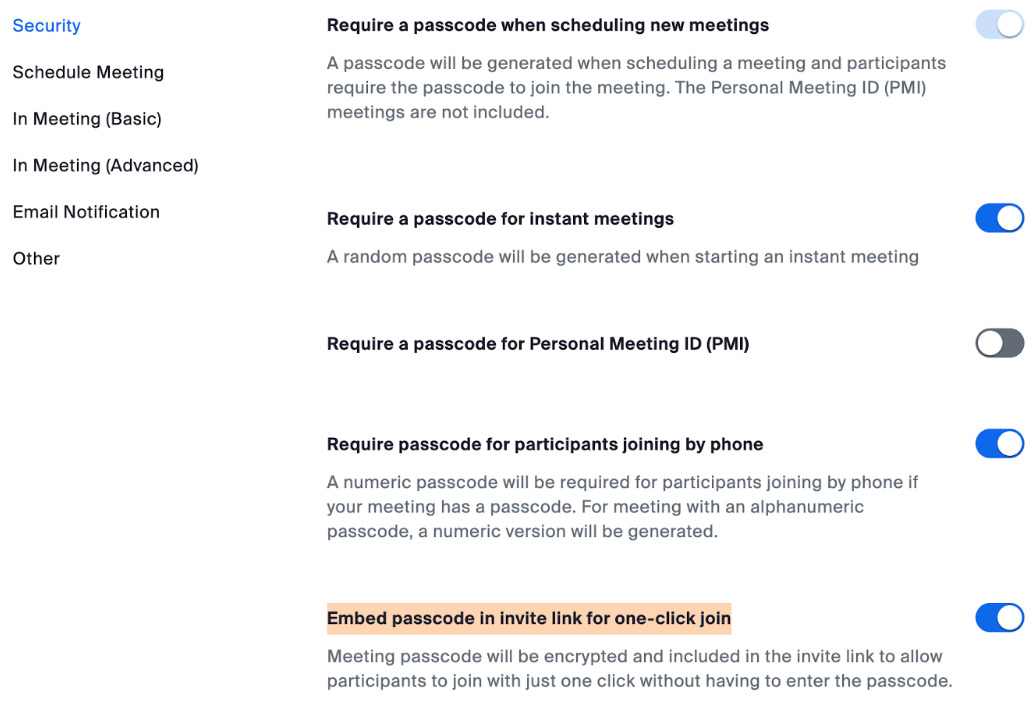
The Zoom links that exposed working meeting rooms all had enabled the highlighted option.
Akiri said the misuse of PMI links, particularly those with passcodes embedded, can give unauthorized individuals access to meetings.
“These one-click links, which are not subject to expiration or password requirement, can be exploited by attackers for impersonation,” Akiri said. “Attackers exploiting these vulnerabilities can impersonate companies, initiating meetings unknowingly to users. They can contact other employees or customers while posing as the company, gaining unauthorized access to confidential information, potentially for financial gain, recruitment, or fraudulent advertising campaigns.”
Akiri said he built a simple program to crawl the web for working Zoom meeting links from different organizations, and so far it has identified thousands of organizations with these perfectly functional zombie Zoom links.
According to Akiri, here are several tips for using Zoom links more safely:
Don’t Use Personal Meeting ID for Public Meetings: Your Personal Meeting ID (PMI) is the default meeting that launches when you start an ad hoc meeting. Your PMI doesn’t change unless you change it yourself, which makes it very useful if people need a way to reach you. But for public meetings, you should always schedule new meetings with randomly generated meeting IDs. That way, only invited attendees will know how to join your meeting. You can also turn off your PMI when starting an instant meeting in your profile settings.
Require a Passcode to Join: You can take meeting security even further by requiring a passcode to join your meetings. This feature can be applied to both your Personal Meeting ID, so only those with the passcode will be able to reach you, and to newly scheduled meetings. To learn all the ways to add a passcode for your meetings, see this support article.
Only Allow Registered or Domain Verified Users: Zoom can also give you peace of mind by letting you know exactly who will be attending your meeting. When scheduling a meeting, you can require attendees to register with their email, name, and custom questions. You can even customize your registration page with a banner and logo. By default, Zoom also restricts participants to those who are logged into Zoom, and you can even restrict it to Zoom users whose email address uses a certain domain.
Further reading: How to Keep Uninvited Guests Out of Your Zoom Meeting
Update 12:33 p.m.: The list of affected organizations was updated, because several companies listed apparently only exposed links that let anyone connect to existing, always-on meeting rooms — not initiate and completely control a Zoom meeting. The real danger with the zombie links described above is that anyone can find and use them to create new meetings and invite others.
The victim shaming site operated by the Snatch ransomware group is leaking data about its true online location and internal operations, as well as the Internet addresses of its visitors, KrebsOnSecurity has found. The leaked data suggest that Snatch is one of several ransomware groups using paid ads on Google.com to trick people into installing malware disguised as popular free software, such as Microsoft Teams, Adobe Reader, Mozilla Thunderbird, and Discord.
First spotted in 2018, the Snatch ransomware group has published data stolen from hundreds of organizations that refused to pay a ransom demand. Snatch publishes its stolen data at a website on the open Internet, and that content is mirrored on the Snatch team’s darknet site, which is only reachable using the global anonymity network Tor.
KrebsOnSecurity has learned that Snatch’s darknet site exposes its “server status” page, which includes information about the true Internet addresses of users accessing the website.
Refreshing this page every few seconds shows that the Snatch darknet site generates a decent amount of traffic, often attracting thousands of visitors each day. But by far the most frequent repeat visitors are coming from Internet addresses in Russia that either currently host Snatch’s clear web domain names or recently did.
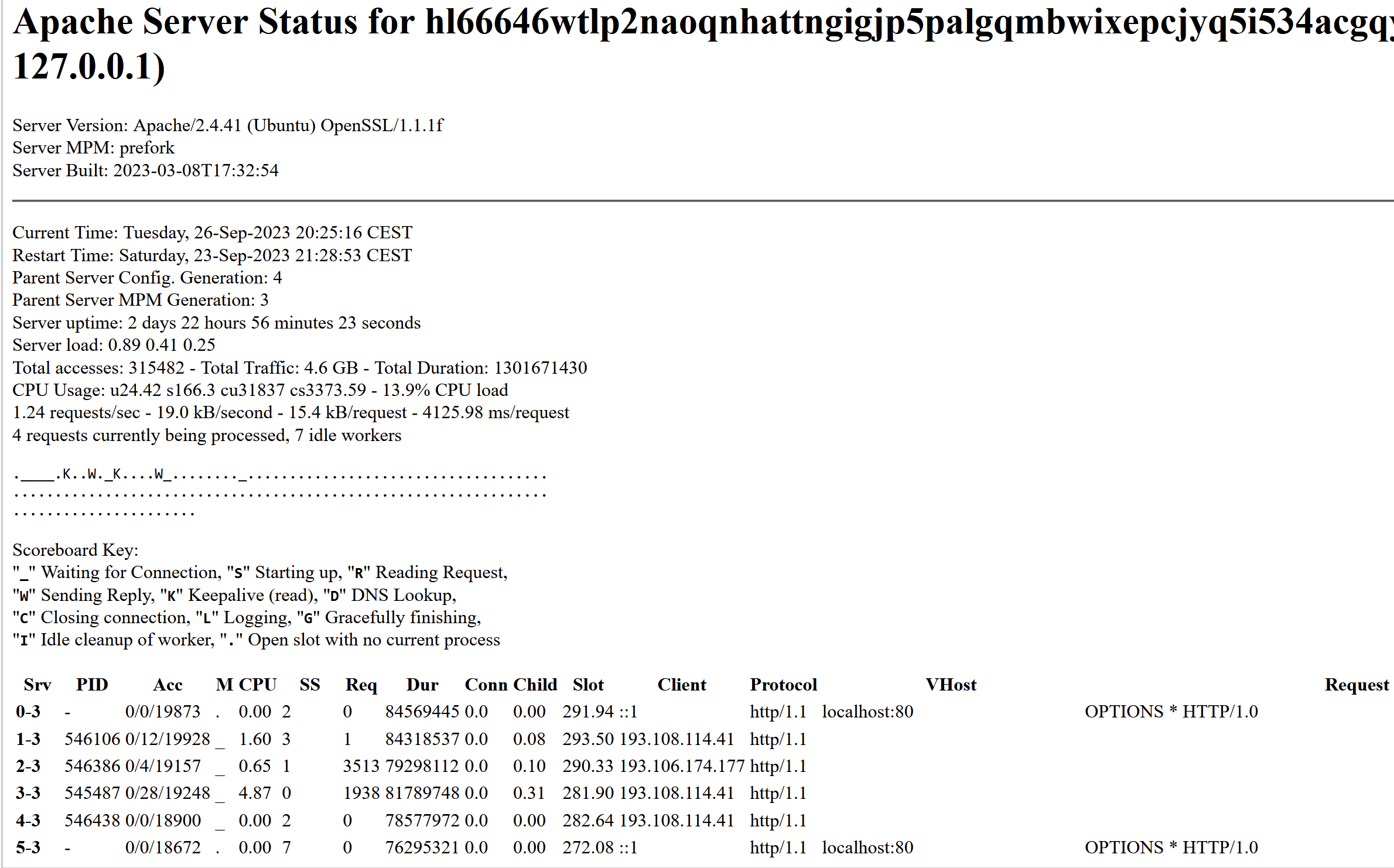
The Snatch ransomware gang’s victim shaming site on the darknet is leaking data about its visitors. This “server status” page says that Snatch’s website is on Central European Summer Time (CEST) and is powered by OpenSSL/1.1.1f, which is no longer supported by security updates.
Probably the most active Internet address accessing Snatch’s darknet site is 193.108.114[.]41, which is a server in Yekaterinburg, Russia that hosts several Snatch domains, including snatchteam[.]top, sntech2ch[.]top, dwhyj2[.]top and sn76930193ch[.]top. It could well be that this Internet address is showing up frequently because Snatch’s clear-web site features a toggle button at the top that lets visitors switch over to accessing the site via Tor.
Another Internet address that showed up frequently in the Snatch server status page was 194.168.175[.]226, currently assigned to Matrix Telekom in Russia. According to DomainTools.com, this address also hosts or else recently hosted the usual coterie of Snatch domains, as well as quite a few domains phishing known brands such as Amazon and Cashapp.
The Moscow Internet address 80.66.64[.]15 accessed the Snatch darknet site all day long, and that address also housed the appropriate Snatch clear-web domains. More interestingly, that address is home to multiple recent domains that appear confusingly similar to known software companies, including libreoff1ce[.]com and www-discord[.]com.
This is interesting because the phishing domains associated with the Snatch ransomware gang were all registered to the same Russian name — Mihail Kolesnikov, a name that is somewhat synonymous with recent phishing domains tied to malicious Google ads.
Kolesnikov could be a nod to a Russian general made famous during Boris Yeltsin’s reign. Either way, it’s clearly a pseudonym, but there are some other commonalities among these domains that may provide insight into how Snatch and other ransomware groups are sourcing their victims.
DomainTools says there are more than 1,300 current and former domain names registered to Mihail Kolesnikov between 2013 and July 2023. About half of the domains appear to be older websites advertising female escort services in major cities around the United States (e.g. the now-defunct pittsburghcitygirls[.]com).
The other half of the Kolesnikov websites are far more recent phishing domains mostly ending in “.top” and “.app” that appear designed to mimic the domains of major software companies, including www-citrix[.]top, www-microsofteams[.]top, www-fortinet[.]top, ibreoffice[.]top, www-docker[.]top, www-basecamp[.]top, ccleaner-cdn[.]top, adobeusa[.]top, and www.real-vnc[.]top.
In August 2023, researchers with Trustwave Spiderlabs said they encountered domains registered to Mihail Kolesnikov being used to disseminate the Rilide information stealer trojan.
But it appears multiple crime groups may be using these domains to phish people and disseminate all kinds of information-stealing malware. In February 2023, Spamhaus warned of a huge surge in malicious ads that were hijacking search results in Google.com, and being used to distribute at least five different families of information stealing trojans, including AuroraStealer, IcedID/Bokbot, Meta Stealer, RedLine Stealer and Vidar.
For example, Spamhaus said victims of these malicious ads would search for Microsoft Teams in Google.com, and the search engine would often return a paid ad spoofing Microsoft or Microsoft Teams as the first result — above all other results. The malicious ad would include a logo for Microsoft and at first glance appear to be a safe and trusted place to download the Microsoft Teams client.
However, anyone who clicked on the result was whisked away instead to mlcrosofteams-us[.]top — yet another malicious domain registered to Mr. Kolesnikov. And while visitors to this website may believe they are only downloading the Microsoft Teams client, the installer file includes a copy of the IcedID malware, which is really good at stealing passwords and authentication tokens from the victim’s web browser.
The founder of the Swiss anti-abuse website abuse.ch told Spamhaus it is likely that some cybercriminals have started to sell “malvertising as a service” on the dark web, and that there is a great deal of demand for this service.
In other words, someone appears to have built a very profitable business churning out and promoting new software-themed phishing domains and selling that as a service to other cybercriminals. Or perhaps they are simply selling any stolen data (and any corporate access) to active and hungry ransomware group affiliates.
The tip about the exposed “server status” page on the Snatch darkweb site came from @htmalgae, the same security researcher who alerted KrebsOnSecurity earlier this month that the darknet victim shaming site run by the 8Base ransomware gang was inadvertently left in development mode.
That oversight revealed not only the true Internet address of the hidden 8Base site (in Russia, naturally), but also the identity of a programmer in Moldova who apparently helped to develop the 8Base code.
@htmalgae said the idea of a ransomware group’s victim shaming site leaking data that they did not intend to expose is deliciously ironic.
“This is a criminal group that shames others for not protecting user data,” @htmalgae said. “And here they are leaking their user data.”
All of the malware mentioned in this story is designed to run on Microsoft Windows devices. But Malwarebytes recently covered the emergence of a Mac-based information stealer trojan called AtomicStealer that was being advertised through malicious Google ads and domains that were confusingly similar to software brands.
Please be extra careful when you are searching online for popular software titles. Cracked, pirated copies of major software titles are a frequent source of infostealer infections, as are these rogue ads masquerading as search results. Make sure to double-check you are actually at the domain you believe you’re visiting *before* you download and install anything.
Stay tuned for Part II of this post, which includes a closer look at the Snatch ransomware group and their founder.
Further reading:
@HTMalgae’s list of the top Internet addresses seen accessing Snatch’s darknet site
Ars Technica: Until Further Notice Think Twice Before Using Google to Download Software
Bleeping Computer: Hackers Abuse Google Ads to Spread Malware in Legit Software
You’ve probably never heard of “16Shop,” but there’s a good chance someone using it has tried to phish you.

A 16Shop phishing page spoofing Apple and targeting Japanese users. Image: Akamai.com.
The international police organization INTERPOL said last week it had shuttered the notorious 16Shop, a popular phishing-as-a-service platform launched in 2017 that made it simple for even complete novices to conduct complex and convincing phishing scams. INTERPOL said authorities in Indonesia arrested the 21-year-old proprietor and one of his alleged facilitators, and that a third suspect was apprehended in Japan.
The INTERPOL statement says the platform sold hacking tools to compromise more than 70,000 users in 43 countries. Given how long 16Shop has been around and how many paying customers it enjoyed over the years, that number is almost certainly highly conservative.
Also, the sale of “hacking tools” doesn’t quite capture what 16Shop was all about: It was a fully automated phishing platform that gave its thousands of customers a series of brand-specific phishing kits to use, and provided the domain names needed to host the phishing pages and receive any stolen credentials.
Security experts investigating 16Shop found the service used an application programming interface (API) to manage its users, an innovation that allowed its proprietors to shut off access to customers who failed to pay a monthly fee, or for those attempting to copy or pirate the phishing kit.
16Shop also localized phishing pages in multiple languages, and the service would display relevant phishing content depending on the victim’s geolocation.

Various 16Shop lures for Apple users in different languages. Image: Akamai.
For example, in 2019 McAfee found that for targets in Japan, the 16Shop kit would also collect Web ID and Card Password, while US victims will be asked for their Social Security Number.
“Depending on location, 16Shop will also collect ID numbers (including Civil ID, National ID, and Citizen ID), passport numbers, social insurance numbers, sort codes, and credit limits,” McAfee wrote.
In addition, 16Shop employed various tricks to help its users’ phishing pages stay off the radar of security firms, including a local “blacklist” of Internet addresses tied to security companies, and a feature that allowed users to block entire Internet address ranges from accessing phishing pages.
The INTERPOL announcement does not name any of the suspects arrested in connection with the 16Shop investigation. However, a number of security firms — including Akamai, McAfee and ZeroFox, previously connected the service to a young Indonesian man named Riswanda Noor Saputra, who sold 16Shop under the hacker handle “Devilscream.”
According to the Indonesian security blog Cyberthreat.id, Saputra admitted being the administrator of 16Shop, but told the publication he handed the project off to others by early 2020.
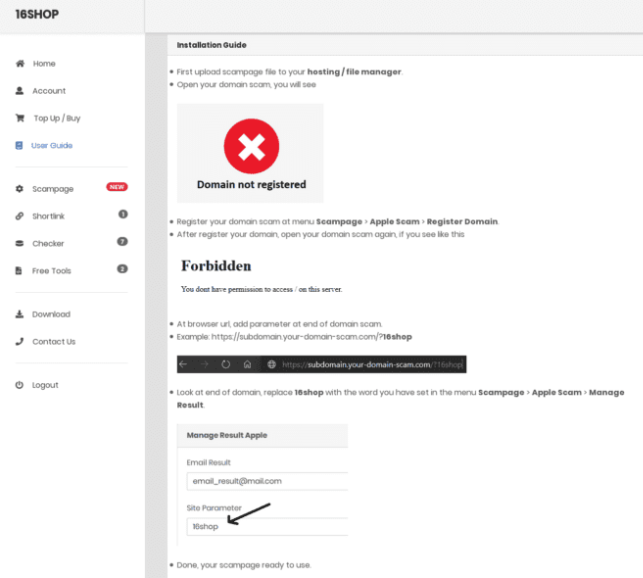
16Shop documentation instructing operators on how to deploy the kit. Image: ZeroFox.
Nevertheless, Cyberthreat reported that Devilscream was arrested by Indonesian police in late 2021 as part of a collaboration between INTERPOL and the U.S. Federal Bureau of Investigation (FBI). Still, researchers who tracked 16Shop since its inception say Devilscream was not the original proprietor of the phishing platform, and he may not be the last.
It is not uncommon for cybercriminals to accidentally infect their own machines with password-stealing malware, and that is exactly what seems to have happened with one of the more recent administrators of 16Shop.
Constella Intelligence, a data breach and threat actor research platform, now allows users to cross-reference popular cybercrime websites and denizens of these forums with inadvertent malware infections by information-stealing trojans. A search in Constella on 16Shop’s domain name shows that in mid-2022, a key administrator of the phishing service infected their Microsoft Windows desktop computer with the Redline information stealer trojan — apparently by downloading a cracked (and secretly backdoored) copy of Adobe Photoshop.
Redline infections steal gobs of data from the victim machine, including a list of recent downloads, stored passwords and authentication cookies, as well as browser bookmarks and auto-fill data. Those records indicate the 16Shop admin used the nicknames “Rudi” and “Rizki/Rizky,” and maintained several Facebook profiles under these monikers.
It appears this user’s full name (or at least part of it) is Rizky Mauluna Sidik, and they are from Bandung in West Java, Indonesia. One of this user’s Facebook pages says Rizky is the chief executive officer and founder of an entity called BandungXploiter, whose Facebook page indicates it is a group focused mainly on hacking and defacing websites.
A LinkedIn profile for Rizky says he is a backend Web developer in Bandung who earned a bachelor’s degree in information technology in 2020. Mr. Rizky did not respond to requests for comment.

John Clifton Davies, a convicted fraudster estimated to have bilked dozens of technology startups out of more than $30 million through phony investment schemes, has a brand new pair of scam companies that are busy dashing startup dreams: A fake investment firm called Equity-Invest[.]ch, and Diligere[.]co.uk, a scam due diligence company that Equity-Invest insists all investment partners use.
A native of the United Kingdom, Mr. Davies absconded from justice before being convicted on multiple counts of fraud in 2015. Prior to his conviction, Davies served 16 months in jail before being cleared on suspicion of murdering his third wife on their honeymoon in India.

The scam artist John Bernard (left) in a recent Zoom call, and a photo of John Clifton Davies from 2015.
John Clifton Davies was convicted in 2015 of swindling businesses throughout the U.K. that were struggling financially and seeking to restructure their debt. For roughly six years, Davies ran a series of firms that pretended to offer insolvency services. Instead, he simply siphoned what little remaining money these companies had, spending the stolen funds on lavish cars, home furnishings, vacations and luxury watches.
In a three-part series published in 2020, KrebsOnSecurity exposed how Davies — wanted by authorities in the U.K. — had fled the country, taken on the surname Bernard, remarried, and moved to his new (and fourth) wife’s hometown in Ukraine.
After eluding justice in the U.K., Davies reinvented himself as The Private Office of John Bernard, pretending to be a billionaire Swiss investor who made his fortunes in the dot-com boom 20 years ago and who was seeking private equity investment opportunities.
In case after case, Bernard would promise to invest millions in hi-tech startups, only to insist that companies pay tens of thousands of dollars worth of due diligence fees up front. However, the due diligence company he insisted on using — another Swiss firm called The Inside Knowledge — also was secretly owned by Bernard, who would invariably pull out of the deal after receiving the due diligence money.
Bernard found a constant stream of new marks by offering extraordinarily generous finders fees to investment brokers who could introduce him to companies seeking an infusion of cash. Inside Knowledge and The Private Office both closed up shop not long after being exposed here in 2020.
In April 2023, KrebsOnSecurity wrote about Codes2You, a recent Davies venture which purports to be a “full cycle software development company” based in the U.K. The company’s website no longer lists any of Davies’ known associates, but the site does still reference software and cloud services tied to those associates — including MySolve, a “multi-feature platform for insolvency practitioners.”
Earlier this month, KrebsOnSecurity heard from an investment broker who found out his client had paid more than $50,000 in due diligence fees related to a supposed multi-million dollar investment offer from a Swiss concern called Equity-Invest[.]ch.
The investment broker, who spoke on condition that neither he nor his client be named, said Equity-Invest began getting cold feet after his client plunked down the due diligence fees.
“Things started to go sideways when the investor purportedly booked a trip to the US to meet the team but canceled last minute because ‘his pregnant wife got in a car accident,'” the broker explained. “After that, he was radio silent until the contract expired.”
The broker said he grew suspicious when he learned that the Equity-Invest domain name was less than six months old. The broker’s suspicions were confirmed after he discovered the due diligence company that Equity-Invest insisted on using — Diligere[.]co.uk — included an email address on its homepage for another entity called Ardelis Solutions.
A corporate entity in the UK called Ardelis Solutions was key to showing the connection to Davies’ former scam investment and due diligence firms in the Codes2You investigation published earlier this year.
Although Diligere’s website claims the due diligence firm has “13 years of experiance” [sic], its domain name was only registered in April 2023. What’s more, virtually all of the vapid corporate-speak published on Diligere’s homepage is identical to text on the now-defunct InsideKnowledge[.]ch — the fake due diligence firm secretly owned for many years by The Private Office of John Bernard (John Clifton Davies).

A snippet of text from the now-defunct website of the fake Swiss investor John Bernard, in real life John Clifton Davies.
“Our steadfast conviction and energy for results is what makes us stand out,” both sites state. “We care for our clients’ and their businesses, we share their ambitions and align our goals to complement their objectives. Our clients know we’re in this together. We work in close partnership with our clients to deliver palpable results regardless of geography, complexity or controversy.”

The copy on Diligere’s homepage is identical to that once on Insideknowledge[.]com, a phony due diligence company run by John Clifton Davies.
One frustrating aspect of email phishing is the frequency with which scammers fall back on tried-and-true methods that really have no business working these days. Like attaching a phishing email to a traditional, clean email message, or leveraging link redirects on LinkedIn, or abusing an encoding method that makes it easy to disguise booby-trapped Microsoft Windows files as relatively harmless documents.
KrebsOnSecurity recently heard from a reader who was puzzled over an email he’d just received saying he needed to review and complete a supplied W-9 tax form. The missive was made to appear as if it were part of a mailbox delivery report from Microsoft 365 about messages that had failed to deliver.
The reader, who asked to remain anonymous, said the phishing message contained an attachment that appeared to have a file extension of “.pdf,” but something about it seemed off. For example, when he downloaded and tried to rename the file, the right arrow key on the keyboard moved his cursor to the left, and vice versa.
The file included in this phishing scam uses what’s known as a “right-to-left override” or RLO character. RLO is a special character within unicode — an encoding system that allows computers to exchange information regardless of the language used — that supports languages written from right to left, such as Arabic and Hebrew.
Look carefully at the screenshot below and you’ll notice that while Microsoft Windows says the file attached to the phishing message is named “lme.pdf,” the full filename is “fdp.eml” spelled backwards. In essence, this is a .eml file — an electronic mail format or email saved in plain text — masquerading as a .PDF file.
“The email came through Microsoft Office 365 with all the detections turned on and was not caught,” the reader continued. “When the same email is sent through Mimecast, Mimecast is smart enough to detect the encoding and it renames the attachment to ‘___fdp.eml.’ One would think Microsoft would have had plenty of time by now to address this.”
Indeed, KrebsOnSecurity first covered RLO-based phishing attacks back in 2011, and even then it wasn’t a new trick.
Opening the .eml file generates a rendering of a webpage that mimics an alert from Microsoft about wayward messages awaiting restoration to your inbox. Clicking on the “Restore Messages” link there bounces you through an open redirect on LinkedIn before forwarding to the phishing webpage.
As noted here last year, scammers have long taken advantage of a marketing feature on the business networking site which lets them create a LinkedIn.com link that bounces your browser to other websites, such as phishing pages that mimic top online brands (but chiefly Linkedin’s parent firm Microsoft).
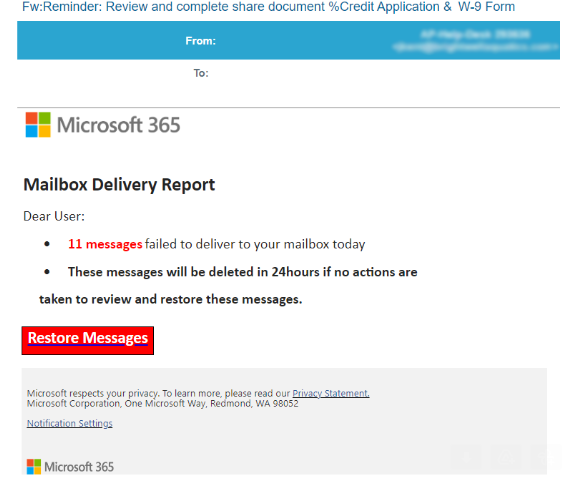
The landing page after the LinkedIn redirect displays what appears to be an Office 365 login page, which is naturally a phishing website made to look like an official Microsoft Office property.
In summary, this phishing scam uses an old RLO trick to fool Microsoft Windows into thinking the attached file is something else, and when clicked the link uses an open redirect on a Microsoft-owned website (LinkedIn) to send people to a phishing page that spoofs Microsoft and tries to steal customer email credentials.
According to the latest figures from Check Point Software, Microsoft was by far the most impersonated brand for phishing scams in the second quarter of 2023, accounting for nearly 30 percent of all brand phishing attempts.
An unsolicited message that arrives with one of these .eml files as an attachment is more than likely to be a phishing lure. The best advice to sidestep phishing scams is to avoid clicking on links that arrive unbidden in emails, text messages and other mediums. Most phishing scams invoke a temporal element that warns of dire consequences should you fail to respond or act quickly.
If you’re unsure whether a message is legitimate, take a deep breath and visit the site or service in question manually — ideally, using a browser bookmark to avoid potential typosquatting sites.

Researchers say mobile malware purveyors have been abusing a bug in the Google Android platform that lets them sneak malicious code into mobile apps and evade security scanning tools. Google says it has updated its app malware detection mechanisms in response to the new research.
At issue is a mobile malware obfuscation method identified by researchers at ThreatFabric, a security firm based in Amsterdam. Aleksandr Eremin, a senior malware analyst at the company, told KrebsOnSecurity they recently encountered a number of mobile banking trojans abusing a bug present in all Android OS versions that involves corrupting components of an app so that its new evil bits will be ignored as invalid by popular mobile security scanning tools, while the app as a whole gets accepted as valid by Android OS and successfully installed.
“There is malware that is patching the .apk file [the app installation file], so that the platform is still treating it as valid and runs all the malicious actions it’s designed to do, while at the same time a lot of tools designed to unpack and decompile these apps fail to process the code,” Eremin explained.
Eremin said ThreatFabric has seen this malware obfuscation method used a few times in the past, but in April 2023 it started finding many more variants of known mobile malware families leveraging it for stealth. The company has since attributed this increase to a semi-automated malware-as-a-service offering in the cybercrime underground that will obfuscate or “crypt” malicious mobile apps for a fee.
Eremin said Google flagged their initial May 9, 2023 report as “high” severity. More recently, Google awarded them a $5,000 bug bounty, even though it did not technically classify their finding as a security vulnerability.
“This was a unique situation in which the reported issue was not classified as a vulnerability and did not impact the Android Open Source Project (AOSP), but did result in an update to our malware detection mechanisms for apps that might try to abuse this issue,” Google said in a written statement.
Google also acknowledged that some of the tools it makes available to developers — including APK Analyzer — currently fail to parse such malicious applications and treat them as invalid, while still allowing them to be installed on user devices.
“We are investigating possible fixes for developer tools and plan to update our documentation accordingly,” Google’s statement continued.
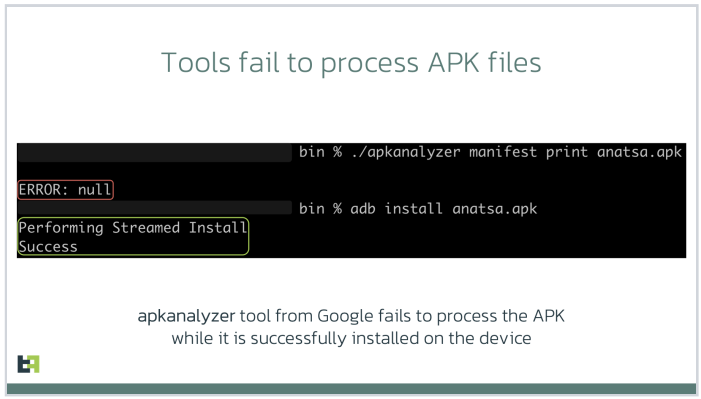
Image: ThreatFabric.
According to ThreatFabric, there are a few telltale signs that app analyzers can look for that may indicate a malicious app is abusing the weakness to masquerade as benign. For starters, they found that apps modified in this way have Android Manifest files that contain newer timestamps than the rest of the files in the software package.
More critically, the Manifest file itself will be changed so that the number of “strings” — plain text in the code, such as comments — specified as present in the app does match the actual number of strings in the software.
One of the mobile malware families known to be abusing this obfuscation method has been dubbed Anatsa, which is a sophisticated Android-based banking trojan that typically is disguised as a harmless application for managing files. Last month, ThreatFabric detailed how the crooks behind Anatsa will purchase older, abandoned file managing apps, or create their own and let the apps build up a considerable user base before updating them with malicious components.
ThreatFabric says Anatsa poses as PDF viewers and other file managing applications because these types of apps already have advanced permissions to remove or modify other files on the host device. The company estimates the people behind Anatsa have delivered more than 30,000 installations of their banking trojan via ongoing Google Play Store malware campaigns.
Google has come under fire in recent months for failing to more proactively police its Play Store for malicious apps, or for once-legitimate applications that later go rogue. This May 2023 story from Ars Technica about a formerly benign screen recording app that turned malicious after garnering 50,000 users notes that Google doesn’t comment when malware is discovered on its platform, beyond thanking the outside researchers who found it and saying the company removes malware as soon as it learns of it.
“The company has never explained what causes its own researchers and automated scanning process to miss malicious apps discovered by outsiders,” Ars’ Dan Goodin wrote. “Google has also been reluctant to actively notify Play users once it learns they were infected by apps promoted and made available by its own service.”
The Ars story mentions one potentially positive change by Google of late: A preventive measure available in Android versions 11 and higher that implements “app hibernation,” which puts apps that have been dormant into a hibernation state that removes their previously granted runtime permissions.





Many things have changed since 2018, such as the names of the companies in the Fortune 100 list. But one aspect of that vaunted list that hasn’t shifted much since is that very few of these companies list any security professionals within their top executive ranks.

The next time you receive a breach notification letter that invariably says a company you trusted places a top priority on customer security and privacy, consider this: Only five of the Fortune 100 companies currently list a security professional in the executive leadership pages of their websites. This is largely unchanged from five of the Fortune 100 in 2018, the last time KrebsOnSecurity performed this analysis.
A review of the executives pages published by the 2022 list of Fortune 100 companies found only five — BestBuy, Cigna, Coca-Cola, Disney and Walmart — that listed a Chief Security Officer (CSO) or Chief Information Security Officer (CISO) in their highest corporate ranks.
One-third of last year’s Fortune 100 companies included a Chief Technology Officer (CTO) in their executive stables; 40 listed Chief Information Officer (CIO) roles, but just 21 included a Chief Risk Officer (CRO).
As I noted in 2018, this is not to say that 95 percent of the Fortune 100 companies don’t have a CISO or CSO in their employ: A review of LinkedIn suggests that most of them in fact do have people in those roles, and experts say some of the largest multinational companies will have multiple people in these positions.
But it is interesting to note which executive positions the top companies deem worth publishing in their executive leadership pages. For example, 88 percent listed a Director of Human Resources (or “Chief People Officer”), and 37 out of 100 included a Chief Marketing Officer.
Not that these roles are somehow more or less important than that of a CISO/CSO within the organization. Nor is the average pay hugely different among all these roles. Yet, considering how much marketing (think consumer/customer data) and human resources (think employee personal/financial data) are impacted by your average data breach, it’s somewhat remarkable that more companies don’t list their chief security personnel among their top ranks.
One likely explanation as to why a great many companies still don’t include their security leaders within their highest echelons is that these employees do not report directly to the company’s CEO, board of directors, or Chief Risk Officer.
The CSO or CISO position traditionally has reported to an executive in a technical role, such as the CTO or CIO. But workforce experts say placing the CISO/CSO on unequal footing with the organization’s top leaders makes it more likely that cybersecurity and risk concerns will take a backseat to initiatives designed to increase productivity and generally grow the business.
“Separation of duties is a fundamental concept of security, whether we’re talking about cyber threats, employee fraud, or physical theft,” said Tari Schreider, an analyst with Datos Insights. “But that critical separation is violated every day with the CISO or CSO reporting to the heads of technology.”
IANS, an organization geared toward CISOs/CSOs and their teams, surveyed more than 500 organizations last year and found roughly 65 percent of CISOs still report to a technical leader, such as the CTO or CIO: IANS found 46 percent of CISOs reported to a CIO, with 15 percent reporting directly to a CTO.
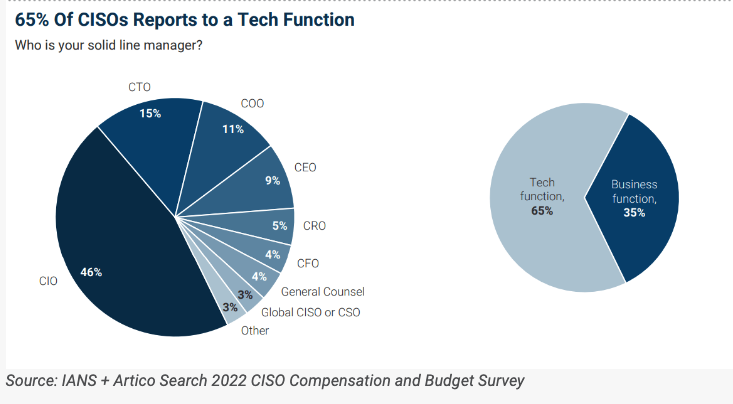
A survey last year by IANS found 65 percent of CISOs report to a tech function within organizations, such as the CTO or CIO. Image: IANS Research.
Schreider said one big reason many CISOs and CSOs aren’t listed in corporate executive biographies at major companies is that these positions often do not enjoy the same legal and insurance protections afforded to other officers within the company.
Typically, larger companies will purchase a “Directors and Officers” liability policy that covers legal expenses should one of the organization’s top executives find themselves dragged into court over some business failing on the part of their employer. But organizations that do not offer this coverage to their security leaders are unlikely to list those positions in their highest ranks, Schreider said.
“It’s frankly shocking,” Schreider said, upon hearing that only four of the Fortune 100 listed any security personnel in their top executive hierarchies. “If the company isn’t going to give them legal cover, then why give them the responsibility for security? Especially when CISOs and CSOs shouldn’t own the risk, yet the majority of them carry the mantle of responsibility and they tend to be scapegoats” when the organization eventually gets hacked, he said.
Schreider said while Datos Insights focuses mostly on the financial and insurance industries, a recent Datos survey echoes the IANS findings from last year. Datos surveyed 25 of the largest financial institutions by asset size (two of which are no longer in existence), and found just 22 percent of CSOs/CISOs reported to the CEO. A majority — 65 percent — had their CSOs/CISOs reporting to either a CTO or CIO.
“I’ve looked at these types of statistics for years and they’ve never really changed that much,” Schreider said. “The CISO or CSO is in the purview of the technical stack from a management perspective. Right, wrong or indifferent, that’s what’s happening.”
Earlier this year, IT consulting firm Accenture released results from surveying more than 3,000 respondents from 15 industries across 14 countries about their security maturity levels. Accenture found that only about one-third of the organizations they surveyed had enough security maturity under their belts to have integrated security into virtually every aspect of their businesses — and this includes having CISOs or CSOs report to someone in charge of overseeing risk for the business as a whole.
Not surprisingly, Accenture also found that only a third of respondents considered cybersecurity risk “to a great extent” when evaluating overall enterprise risk.
“This highlights there is still some way to go to make cybersecurity a proactive, strategic necessity within the business,” the report concluded.
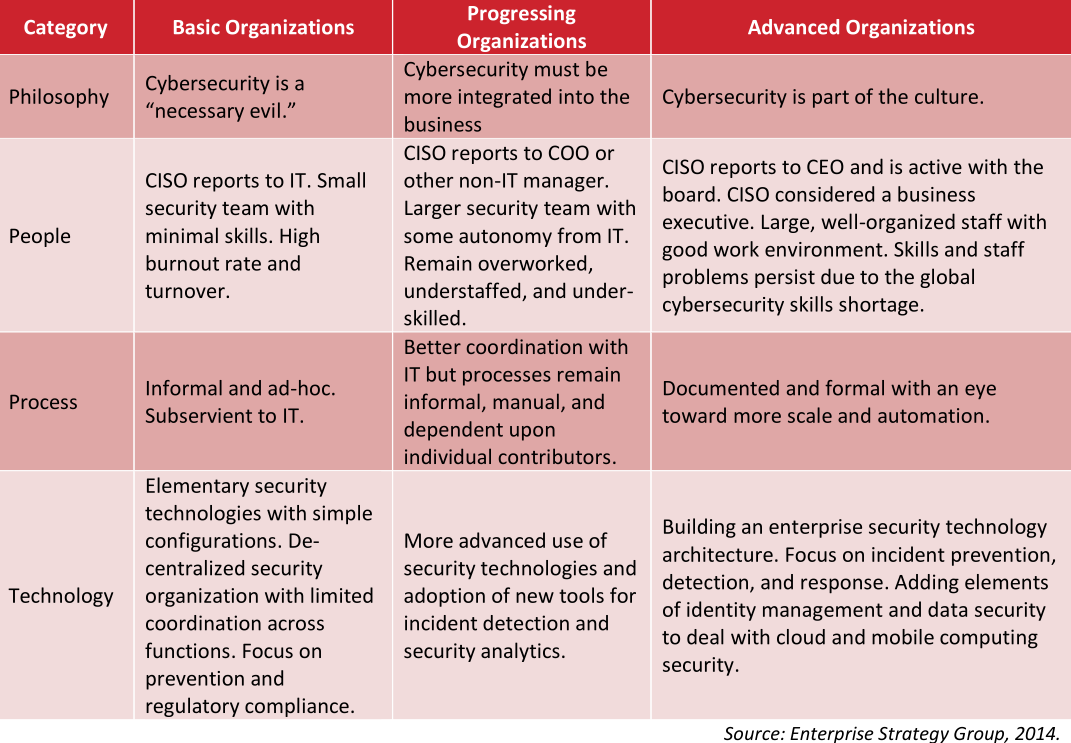
One way of depicting the different stages of security maturity.
A spreadsheet tracking the prevalence of security leaders on the executive pages of the 2022 Fortune 100 firms is available here.
Update, July 23: Somehow overlooked Disney’s CSO listed on their leadership page. The story copy above has been updated to reflect that.
Why is kids’ personal information in high demand, how do criminals steal it, and what can parents do to help prevent child identity theft?
The post Child identity theft: how do I keep my kids’ personal data safe? appeared first on WeLiveSecurity